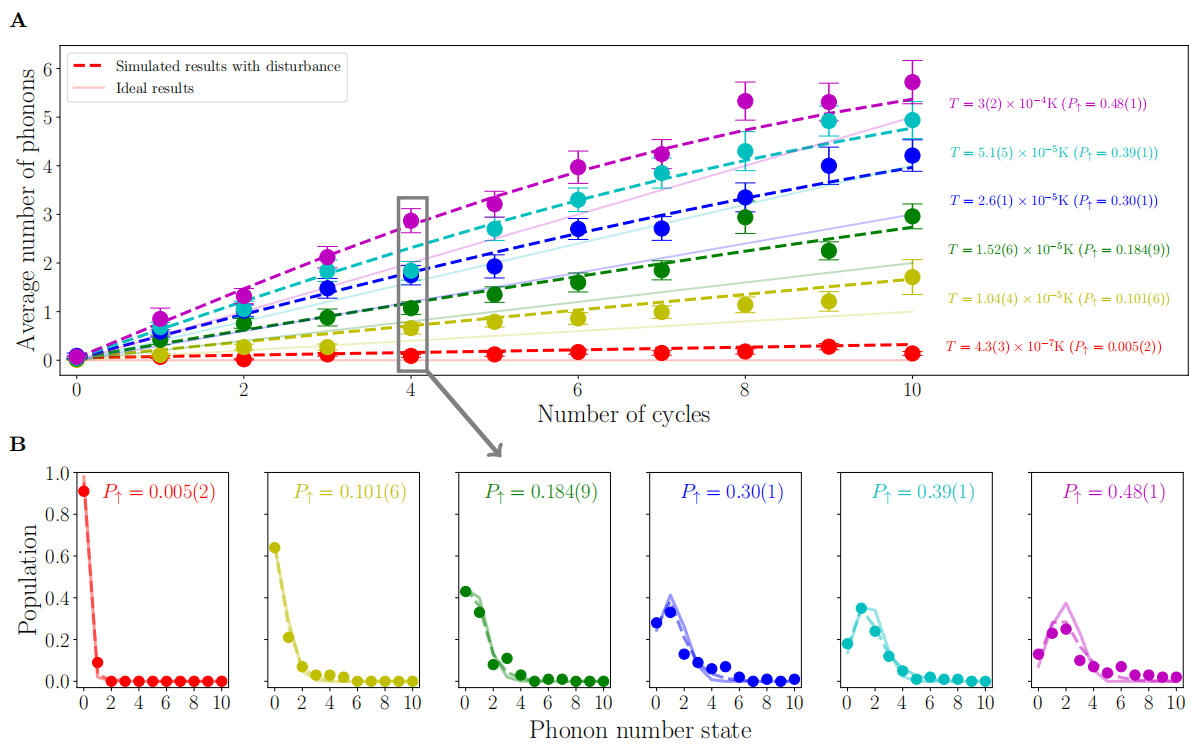Heat engines convert thermal energy into mechanical work in a cyclic process. Similarly, information engines convert information into usable energy. The concept dates back to Maxwell’s demon and was later formalized in the Szilard engine. Classical implementations have used colloidal particles, biological systems, and single-electron devices. Theoretical and experimental studies have extended into the quantum regime, and researchers have attempted experimental implementations of quantum information engines at a rudimentary level on platforms such as superconducting qubits, nuclear spins, and photonic systems. However, realizing a fully cyclic quantum information engine with an external load, capable of precise and repeatable work extraction, such as charging a quantum battery, remains a critical challenge .
This work reports the realization of a fully cyclic quantum information engine using a single trapped ion, where the motional mode functions as a quantum battery. The engine extracts mechanical energy from information in a fully measurable, repeatable manner. By implementing fast, high-fidelity state detection and adiabatic feedback, the researchers directly quantify both the energy and ergotropy of the quantum battery after each engine cycle, enabling precise evaluation of information-to-work conversion. To further characterize performance, the researchers introduce a general metric—the information-to-ergotropy conversion efficiency, which provides a broadly applicable benchmark for quantum information engines with external loads.

Fig. 1. The quantum battery charged by the information engine. At different temperatures, the energy of the quantum battery increases as the engine operates. (a) The average phonon numbers of the mechanical oscillator, proportional to the average energy of the quantum battery, increase as the number of engine cycles. (b) Examples of phonon number distributions, obtained by applying phonon-number-resolving detection after the engine runs for four cycles.
The average phonon number of the quantum battery increases steadily with each engine cycle, as shown in Fig. 1(a). Experiments were conducted across six simulated bath temperatures, corresponding to different thermal populations. Prior to engine operation, the mechanical oscillator is initialized close to its ground state with an average phonon number of 0.009(2). After up to ten cycles, the phonon distribution is extracted using phonon-number-resolving detection [Fig. 1(b)]. However, the observed values exceed ideal predictions due to additional energy introduced by fluorescence scattering and phonon detection imperfections.

Fig. 2. The ergotropy and the information-to-energy conversion efficiencies. (a) The ergotropy of the quantum battery with the number of cycles. Various colors represent different temperatures of the heat bath consistent with Fig. 3. (b) The efficiency of information-to-work conversion. (c) The efficiency of information-to-ergotropy conversion .
The maximum extractable work from a quantum system is quantified by ergotropy, which serves as a measure of the useful energy in a quantum battery. Notably, the useful energy charged into the quantum battery shown in Fig. 2(a) is significantly lower than the average energy increase depicted in Fig. 1(a). The energy conversion efficiency of the quantum information engine is quantified through the calculation of two specific efficiencies: information-to-work conversion efficiency and information-to-ergotropy conversion efficiency, as illustrated in Figs. 2(B) and 2(C), respectively. The information-to-ergotropy conversion efficiency characterizes the practical performance of the engine. In this work, this efficiency is equivalent to the charging efficiency of the quantum battery, with the highest observed efficiency in the experiment being 5.83%.
This work was published in "Physical Review Letters" on September 30, 2025 under the title "Single-Ion Information Engine for Charging Quantum Battery". The equally contributed first authors of the paper are Jialiang Zhang, a PHD student at Tsinghua University, and Pengfei Wang, an assistant researcher at BAQIS. The corresponding authors is Professor Kihwan Kim at Tsinghua University and a researcher at BAQIS. This research was funded by the Quantum Science and Technology Innovation Program and the National Natural Science Foundation of China.